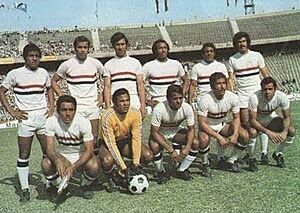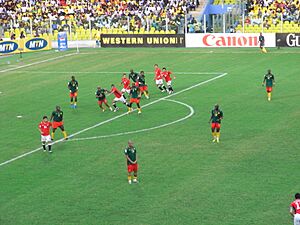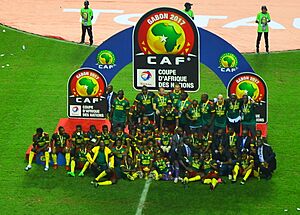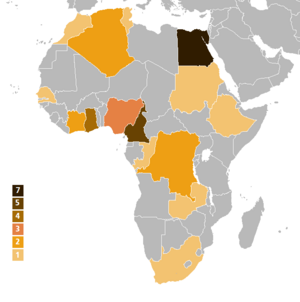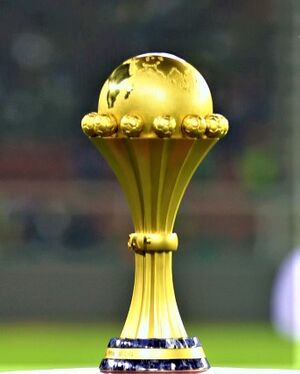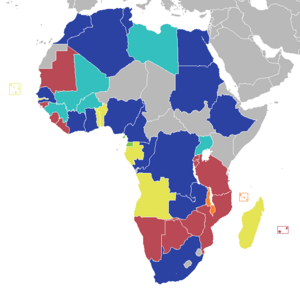Africa Cup of Nations facts for kids
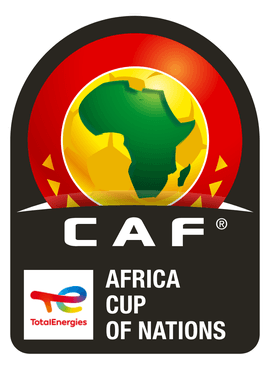 |
|
| Organising body | CAF |
|---|---|
| Founded | 1957 |
| Region | Africa |
| Number of teams | 24 (finals) 54 (eligible to enter qualification) |
| Current champions | (3rd title) |
| Most successful team(s) | (7 titles) |
The Africa Cup of Nations, often called AFCON, is the biggest international football competition for men's teams in Africa. It is organized by the Confederation of African Football (CAF). The tournament first started in 1957.
Since 1968, it has been held every two years. In 2013, it switched to being held in odd-numbered years. This change was made so it would not happen in the same year as the FIFA World Cup.
In the very first tournament in 1957, only three countries played: Egypt, Sudan, and Ethiopia. South Africa was supposed to join but was not allowed to play. This was because of their government's unfair rules about race, known as apartheid.
Over the years, the tournament grew a lot. More teams wanted to play, so a special qualifying round became necessary. By 1998, 16 teams competed in the final tournament. In 2017, a big change happened: the tournament moved from January to June. Also, the number of teams in the final competition increased from 16 to 24.
Egypt is the most successful team, having won the cup seven times. Cameroon has won five times, and Ghana has won four times. There have been three different trophies given out over the years. The current trophy was first used in 2002. Egypt made history by winning three times in a row in 2006, 2008, and 2010. Ivory Coast are the current champions. They won the 2023 final by beating Nigeria 2–1.
Contents
History of the Africa Cup of Nations
How the Tournament Began (1950s–1960s)
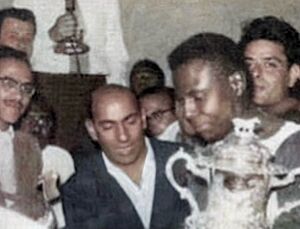
The idea for the Africa Cup of Nations started in June 1956. The first tournament was held in February 1957 in Khartoum, Sudan. Only the four founding nations of CAF were invited: Egypt, Sudan, Ethiopia, and South Africa. However, South Africa was disqualified because of its apartheid policy, which meant they only wanted to pick white players.
Because South Africa was out, Ethiopia got to go straight to the final. So, only two matches were played. Egypt became the first champion by beating Sudan 2–1 in the semi-final and then Ethiopia 4–0 in the final.
Two years later, in 1959, Egypt hosted the second tournament in Cairo. The same three teams played, and Egypt won again, beating Sudan 2–1 in the final.
By 1962, nine teams wanted to play in the third tournament in Addis Ababa. This was the first time teams had to play in a qualifying round to reach the final four. Host Ethiopia and defending champion Egypt automatically qualified. They were joined by Nigeria and Tunisia. Egypt reached its third final in a row, but Ethiopia won the cup in extra time.
Ghana's Strong Years (1960s)
In 1963, Ghana played in the tournament for the first time as the host country. They won the title by beating Sudan in the final. Two years later, in Tunisia, Ghana won again, becoming two-time champions like Egypt.
Starting in 1968, the tournament expanded to include eight teams. These teams were divided into two groups of four. The top two teams from each group moved on to the semi-finals. This system was used until 1992. The Democratic Republic of Congo won its first title in 1968, beating Ghana in the final.
From 1968 onwards, the competition was held every two years in even-numbered years. This changed after the 2012 tournament, when it moved to odd-numbered years. This was done to avoid clashing with the FIFA World Cup. The 1970 tournament in Sudan was the first to be shown on television. Sudan won the trophy, defeating Ghana, who were playing in their fourth final in a row.
Many Different Winners (1970s)
Between 1970 and 1980, six different countries won the title. These included Sudan, Congo-Brazzaville, Zaire, Morocco, Ghana, and Nigeria.
Zaire won its second title in 1974 after playing Zambia in the final. This match was unique because it ended in a 2–2 draw after extra time, so it had to be replayed two days later. Zaire won the replay 2–0. Their forward, Mulamba Ndaye, scored all four of Zaire's goals in these two matches. He also set a record for most goals in a single tournament with nine goals.
Morocco won their first title in 1976. Ghana won its third championship in 1978, becoming the first country to win three titles.
Cameroon's Strong Period (1980s)
Between 1980 and 1990, Cameroon reached the Africa Cup final three times in a row. They won the competition twice, in 1984 and 1988. They lost once to Egypt in a penalty shootout in 1986.
Algeria was another strong team during this time. They lost in the final against host Nigeria in the 1980 tournament. This allowed Nigeria to win their first championship. Algeria reached the semi-finals in almost every tournament after 1980, until they finally won the competition in 1990. Ghana won its fourth title in the 1982 tournament, beating host Libya in the final after a penalty shootout.
South Africa Returns (1990s)
In 1990, Algeria hosted and won their first championship, beating Nigeria 1–0 in the final. Nigeria had now lost three finals in four tournaments.
The 1992 Cup of Nations expanded to 12 teams. They were divided into four groups of three. The top two teams from each group moved to the quarter-finals. Ghana reached the final, but their star player, Abedi "Pele" Ayew, was suspended for the match. Ghana lost to Ivory Coast in a very long penalty shootout. Ivory Coast set a record by not letting any opponent score against them in all six matches of the tournament.
In 1994, Nigeria won the tournament, beating Zambia. Zambia's team had faced a terrible tragedy a year before when most of their national squad died in a plane crash.
South Africa hosted the tournament in 1996. This was their first time playing after a long ban was lifted when apartheid ended. The number of teams in the final round increased to 16. However, Nigeria pulled out at the last minute, so only 15 teams played. Bafana Bafana (South Africa's team) won their first title at home, defeating Tunisia in the final. Two years later, South Africa reached the final again but lost to Egypt, who claimed their fourth cup.
Egypt's Amazing Wins (2000s)
The 2000 tournament was hosted by Ghana and Nigeria. Cameroon won by beating Nigeria in a penalty shootout after the final ended in a 2–2 draw. In 2002, Cameroon's Indomitable Lions won their second title in a row. This was the first time a team had won back-to-back titles since Ghana in the 1960s. Cameroon beat Senegal in a penalty shootout.
In 2004, Tunisia hosted and won their first title, beating Morocco 2–1 in the final. The 2006 tournament was also won by the hosts, Egypt. They reached a record fifth title.
Before the 2008 Africa Cup of Nations, some European clubs wanted the tournament schedule to change. This was because it happens during the European football season, and players miss club matches. In 2008, FIFA president Sepp Blatter said he wanted the tournament to be held in June or July by 2016. This would fit better with the international football calendar. However, this would make it hard for many countries in central and west Africa to host, as those months are their wet season. Ghana hosted the 2008 tournament, and Egypt won again, beating Cameroon 1–0 in the final. This was Egypt's record-extending sixth title.
Changes in the 2010s
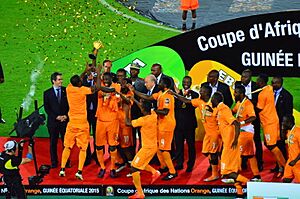
Egypt set a new record in the 2010 tournament (hosted by Angola). They won their third title in a row, which was an amazing achievement in African football. They beat Ghana 1–0 in the final, keeping the gold-plated cup forever and extending their record to seven titles. Egypt became the first African nation to win three consecutive cups.
In May 2010, it was announced that the tournament would move to odd-numbered years starting from 2013. This was to stop it from happening in the same year as the FIFA World Cup. This meant there were two tournaments within twelve months: January 2012 and January 2013.
In 2012, Zambia won the final after a penalty shootout against Ivory Coast. This match gained a lot of attention because it happened in Gabon, very close to where their national team's plane crashed in 1993. Nigeria won the 2013 tournament, beating Burkina Faso, who were playing in their first final.
The West African Ebola virus epidemic affected the tournament in 2014–15. The 2015 Africa Cup of Nations was supposed to be in Morocco, but they refused to host due to Ebola concerns. So, it was moved to Equatorial Guinea. In July 2016, Total (an energy company) became a major sponsor, and the tournament was renamed the "Total Africa Cup of Nations."
Tournament Expansion and Date Change (Since 2019)
In July 2017, two big changes were approved for the Africa Cup of Nations. The tournament would move from January to the Northern Hemisphere summer. Also, it would expand from 16 to 24 teams, starting with the 2019 Africa Cup of Nations.
Algeria won the African Cup of Nations 2019, beating Senegal 1–0 in the final. This was Algeria's second title ever and their first since 1990. Nigeria finished third. The winning team in 2019 received $4.5 million.
The COVID-19 pandemic caused delays for the 2021 Africa Cup of Nations qualifiers. The main tournament, hosted by Cameroon, was postponed to 2022. The prize money for the winner increased to $5 million for the 2021 Africa Cup of Nations. Senegal won the tournament for the first time, defeating Egypt on penalties in the final.
Due to hot weather in Africa, and more recently because of the new FIFA Club World Cup tournament, AFCON has sometimes been held in January of the following year. For example, the 2025 tournament will start in December 2025. The 2029 tournament will also be played around January 2030, starting in December 2029, because of the 2029 FIFA Club World Cup.
How the Tournament Works
The number of teams and the way the tournament is played have changed over the years. Most tournaments have a group stage where teams play each other once. After that, there's a knockout stage where teams are eliminated if they lose.
| Year | Teams | Matches | Format | |
|---|---|---|---|---|
| Min. | Act. | |||
| 1957 | 3 | 2 | semi-final, final | |
| 1959 | 3 | 3 | round-robin group of 3 | |
| 1962 | 4 | 4 | semi-finals, 3rd-place match, final | |
| 1963 | 6 | 8 | 2 groups of 3, 3rd-place match, final | |
| 1965 | 6 | 8 | ||
| 1968 | 8 | 16 | 2 groups of 4, semi-finals, 3rd-place match, final | |
| 1970 | 8 | 16 | ||
| 1972 | 8 | 16 | ||
| 1974 | 8 | 16 | 17 | |
| 1976 | 8 | 18 | 2 groups of 4, final round-robin group of 4 | |
| 1978 | 8 | 16 | 2 groups of 4, semi-finals, 3rd-place match, final | |
| 1980 | 8 | 16 | ||
| 1982 | 8 | 16 | ||
| 1984 | 8 | 16 | ||
| 1986 | 8 | 16 | ||
| 1988 | 8 | 16 | ||
| 1990 | 8 | 16 | ||
| 1992 | 12 | 20 | 4 groups of 3, quarter-finals, semi-finals, 3rd-place match, final | |
| 1994 | 12 | 20 | ||
| 1996 | 15 | 29 | 4 groups of 3–4, quarter-finals, semi-finals, 3rd-place match, final | |
| 1998 | 16 | 32 | 4 groups of 4, quarter-finals, semi-finals, 3rd-place match, final | |
| 2000 | 16 | 32 | ||
| 2002 | 16 | 32 | ||
| 2004 | 16 | 32 | ||
| 2006 | 16 | 32 | ||
| 2008 | 16 | 32 | ||
| 2010 | 15 | 29 | 4 groups of 3–4, quarter-finals, semi-finals, 3rd-place match, final | |
| 2012 | 16 | 32 | 4 groups of 4, quarter-finals, semi-finals, 3rd-place match, final | |
| 2013 | 16 | 32 | ||
| 2015 | 16 | 32 | ||
| 2017 | 16 | 32 | ||
| 2019 | 24 | 52 | 6 groups of 4, round of 16, quarter-finals, semi-finals, 3rd-place match, final | |
| 2021 | 24 | 52 | ||
| 2023 | 24 | 52 | ||
| 2025 | 24 | 52 | ||
| 2027 | 24 | 52 | ||
Since 1962, the competition has two main parts: a qualification phase and a final tournament. The country hosting the final tournament automatically gets a spot. In the early years, the defending champion also automatically qualified for the next tournament.
Qualifying for the Tournament
The way teams qualify has changed as more nations joined the Confederation of African Football (CAF). It started in 1962. Before that, only the founding nations played in the final tournament.
In 1962, new countries joined, so CAF created a qualifying phase with knockout matches. This system was used until 1992. After that, the qualifying phase became more like the UEFA European Championship. Teams play in groups, and the best teams from each group qualify for the final tournament.
The Final Tournament Phase
Only the host country gets an automatic spot. The other 23 teams qualify through a special qualification tournament. In the finals, the 24 teams are divided into six groups of four teams. Each team in a group plays every other team in that group once.
After the group stage, the top two teams from each group move on. Also, the four best third-placed teams get to advance to the "round of 16." The winners of these matches go to the quarter-finals, then the semi-finals. The teams that lose in the semi-finals play for third place, while the winners play in the final match.
Trophies and Medals
Throughout the history of the Africa Cup of Nations, three different trophies have been given to the winners. The first trophy was made of silver and was called the Abdelaziz Abdallah Salem Trophy. It was named after the first CAF president. Ghana got to keep this trophy forever in 1978 because they were the first team to win the tournament three times.
The second trophy was used from 1980 to 2000. It was called the "Trophy of African Unity." It was a cylindrical shape with the Olympic rings and a map of Africa on it. Cameroon won this trophy permanently after they became three-time champions in 2000.
In 2001, the third trophy was introduced. It is a gold-plated cup designed in Italy. Cameroon was the first nation to win this new trophy in 2002. Egypt won this gold-plated cup permanently after they became three-time champions in 2010. However, unlike previous winners, Egypt received a special full-size replica to keep. The winner of each tournament now receives a replica trophy that is the same size as the original.
CAF gives 30 gold medals to the winning team, 30 silver medals to the runners-up, and 30 bronze medals to the third-place team. The fourth-place team receives 30 diplomas.
Tournament Results
Summary of Winners
| Team | Winners | Runners-up | Third place | Fourth place | Total |
|---|---|---|---|---|---|
| 7 (1957, 1959*1, 1986*, 1998, 2006*, 2008, 2010) | 3 (19621, 2017, 2021) | 3 (19631, 19701, 1974*) | 3 (1976, 1980, 1984) | 16 | |
| 5 (1984, 1988, 2000, 2002, 2017) | 2 (1986, 2008) | 2 (1972*, 2021*) | 1 (1992) | 10 | |
| 4 (1963*, 1965, 1978*, 1982) | 5 (1968, 1970, 1992, 2010, 2015) | 1 (2008*) | 4 (1996, 2012, 2013, 2017) | 14 | |
| 3 (1980*, 1994, 2013) | 5 (1984, 1988, 1990, 2000*, 2023) | 8 (1976, 1978, 1992, 2002, 2004, 2006, 2010, 2019) | — | 16 | |
| 3 (1992, 2015, 2023*) | 2 (2006, 2012) | 4 (1965, 1968, 1986, 1994) | 2 (1970, 2008) | 11 | |
| 2 (1990*, 2019) | 1 (1980) | 2 (1984, 1988) | 2 (1982, 2010) | 7 | |
| 2 (19682, 19743) | — | 2 (1998, 2015) | 2 (19723, 2023) | 6 | |
| 1 (2012) | 2 (1974, 1994) | 3 (1982, 1990, 1996) | — | 6 | |
| 1 (2004*) | 2 (1965*, 1996) | 1 (1962) | 3 (1978, 2000, 2019) | 7 | |
| 1 (1970*) | 2 (1959, 1963) | 1 (1957*) | — | 4 | |
| 1 (2021) | 2 (2002, 2019) | — | 3 (1965, 1990, 2006) | 6 | |
| 1 (1996*) | 1 (1998) | 2 (2000, 2023) | — | 4 | |
| 1 (1962*) | 1 (1957) | 1 (1959) | 2 (1963, 1968*) | 5 | |
| 1 (1976) | 1 (2004) | 1 (1980) | 2 (1986, 1988*) | 5 | |
| 1 (1972) | — | — | 1 (1974) | 2 | |
| — | 1 (1972) | 2 (2012, 2013) | 3 (1994, 2002*, 2004) | 6 | |
| — | 1 (2013) | 1 (2017) | 2 (1998*, 2021) | 4 | |
| — | 1 (1978) | — | 1 (1962) | 2 | |
| — | 1 (1976) | — | — | 1 | |
| — | 1 (1982*) | — | — | 1 | |
| — | — | — | 1 (2015*) | 1 |
-
* hosts
- 1 as United Arab Republic
- 2 as Congo-Kinshasa
- 3 as Zaire
All-Time Records
| Tournaments | Matches | Goals scored | Goals per match |
|---|---|---|---|
| 1957 | 2 | 7 | 3.50 |
| 1959 | 3 | 8 | 2.67 |
| 1962 | 4 | 18 | 4.50 |
| 1963 | 8 | 33 | 4.13 |
| 1965 | 8 | 31 | 3.88 |
| 1968 | 16 | 52 | 3.25 |
| 1970 | 16 | 51 | 3.19 |
| 1972 | 16 | 53 | 3.31 |
| 1974 | 17 | 54 | 3.18 |
| 1976 | 18 | 54 | 3.00 |
| 1978 | 16 | 38 | 2.38 |
| 1980 | 16 | 33 | 2.06 |
| 1982 | 16 | 32 | 2.00 |
| 1984 | 16 | 39 | 2.44 |
| 1986 | 16 | 31 | 1.94 |
| 1988 | 16 | 23 | 1.44 |
| 1990 | 16 | 30 | 1.88 |
| 1992 | 20 | 34 | 1.70 |
| 1994 | 20 | 44 | 2.20 |
| 1996 | 29 | 78 | 2.69 |
| 1998 | 32 | 93 | 2.91 |
| 2000 | 32 | 73 | 2.28 |
| 2002 | 32 | 48 | 1.50 |
| 2004 | 32 | 88 | 2.75 |
| 2006 | 32 | 73 | 2.28 |
| 2008 | 32 | 99 | 3.09 |
| 2010 | 29 | 71 | 2.45 |
| 2012 | 32 | 76 | 2.38 |
| 2013 | 32 | 69 | 2.16 |
| 2015 | 32 | 68 | 2.13 |
| 2017 | 32 | 66 | 2.06 |
| 2019 | 52 | 102 | 1.96 |
| 2021 | 52 | 100 | 1.92 |
| 2023 | 52 | 119 | 2.29 |
Champions by Region
| Regional federation | Champion(s) | Title(s) |
|---|---|---|
| WAFU (West Africa) | Ghana (4), Ivory Coast (3), Nigeria (3), Senegal (1) | 11 |
| UNAF (North Africa) | Egypt (7), Algeria (2), Morocco (1), Tunisia (1) | 11 |
| UNIFFAC (Central Africa) | Cameroon (5), DR Congo (2), Congo (1) | 8 |
| COSAFA (Southern Africa) | South Africa (1), Zambia (1) | 2 |
| CECAFA (East Africa) | Ethiopia (1), Sudan (1) | 2 |
Winning Multiple Times in a Row
Some teams have won the Africa Cup of Nations two or even three times in a row.
| Team | Two championships | Three championships |
|---|---|---|
| 1957, 1959 | 2006, 2008, 2010 | |
| 1963, 1965 | — | |
| 2000, 2002 | — |
Bold indicates the tournament hosts.
Awards Given Out
After each tournament, several awards are given to players and teams:
- The Best Player award goes to the most valuable player.
- The Top Goal-scorer award is for the player who scores the most goals.
- The Best Goalkeeper award is for the best goalkeeper.
- The Best Young Player award is for the most outstanding young player.
- The Team of the Tournament is a list of the best players from all teams.
- The Fair Play Award goes to the team with the best sportsmanship.
See also
 In Spanish: Copa Africana de Naciones para niños
In Spanish: Copa Africana de Naciones para niños
- African Nations Championship
- Women's Africa Cup of Nations
- U-23 Africa Cup of Nations
- U-20 Africa Cup of Nations
- U-17 Africa Cup of Nations
- List of Africa Cup of Nations official mascots
- List of Africa Cup of Nations official match balls
- List of Africa Cup of Nations songs and anthems
- List of association football competitions


